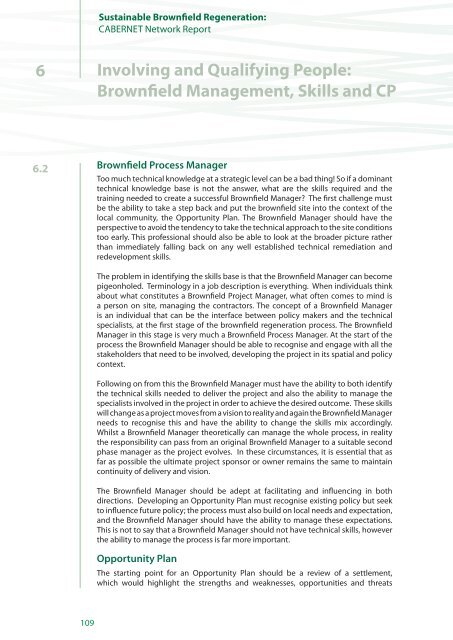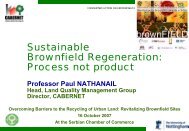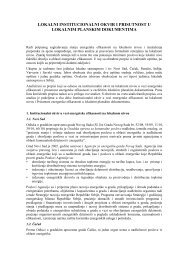Sustainable Brownfield Regeneration: CABERNET Network Report
Sustainable Brownfield Regeneration: CABERNET Network Report
Sustainable Brownfield Regeneration: CABERNET Network Report
Create successful ePaper yourself
Turn your PDF publications into a flip-book with our unique Google optimized e-Paper software.
<strong>Sustainable</strong> <strong>Brownfield</strong> <strong>Regeneration</strong>:<strong>CABERNET</strong> <strong>Network</strong> <strong>Report</strong>6Involving and Qualifying People:<strong>Brownfield</strong> Management, Skills and CP6.2 <strong>Brownfield</strong> Process ManagerToo much technical knowledge at a strategic level can be a bad thing! So if a dominanttechnical knowledge base is not the answer, what are the skills required and thetraining needed to create a successful <strong>Brownfield</strong> Manager? The first challenge mustbe the ability to take a step back and put the brownfield site into the context of thelocal community, the Opportunity Plan. The <strong>Brownfield</strong> Manager should have theperspective to avoid the tendency to take the technical approach to the site conditionstoo early. This professional should also be able to look at the broader picture ratherthan immediately falling back on any well established technical remediation andredevelopment skills.The problem in identifying the skills base is that the <strong>Brownfield</strong> Manager can becomepigeonholed. Terminology in a job description is everything. When individuals thinkabout what constitutes a <strong>Brownfield</strong> Project Manager, what often comes to mind isa person on site, managing the contractors. The concept of a <strong>Brownfield</strong> Manageris an individual that can be the interface between policy makers and the technicalspecialists, at the first stage of the brownfield regeneration process. The <strong>Brownfield</strong>Manager in this stage is very much a <strong>Brownfield</strong> Process Manager. At the start of theprocess the <strong>Brownfield</strong> Manager should be able to recognise and engage with all thestakeholders that need to be involved, developing the project in its spatial and policycontext.Following on from this the <strong>Brownfield</strong> Manager must have the ability to both identifythe technical skills needed to deliver the project and also the ability to manage thespecialists involved in the project in order to achieve the desired outcome. These skillswill change as a project moves from a vision to reality and again the <strong>Brownfield</strong> Managerneeds to recognise this and have the ability to change the skills mix accordingly.Whilst a <strong>Brownfield</strong> Manager theoretically can manage the whole process, in realitythe responsibility can pass from an original <strong>Brownfield</strong> Manager to a suitable secondphase manager as the project evolves. In these circumstances, it is essential that asfar as possible the ultimate project sponsor or owner remains the same to maintaincontinuity of delivery and vision.The <strong>Brownfield</strong> Manager should be adept at facilitating and influencing in bothdirections. Developing an Opportunity Plan must recognise existing policy but seekto influence future policy; the process must also build on local needs and expectation,and the <strong>Brownfield</strong> Manager should have the ability to manage these expectations.This is not to say that a <strong>Brownfield</strong> Manager should not have technical skills, howeverthe ability to manage the process is far more important.Opportunity PlanThe starting point for an Opportunity Plan should be a review of a settlement,which would highlight the strengths and weaknesses, opportunities and threats109
















